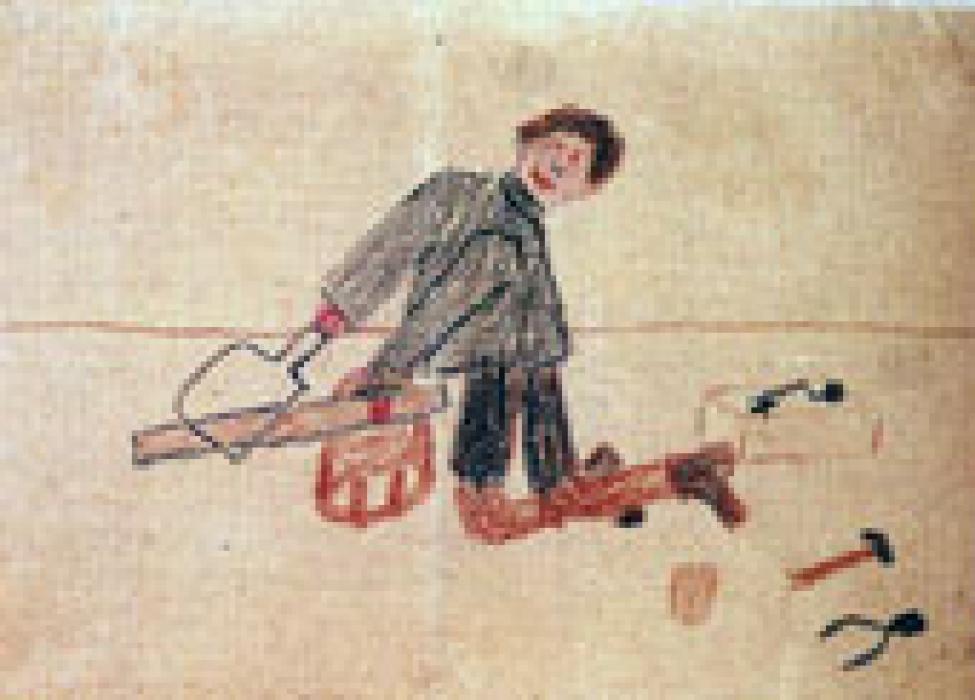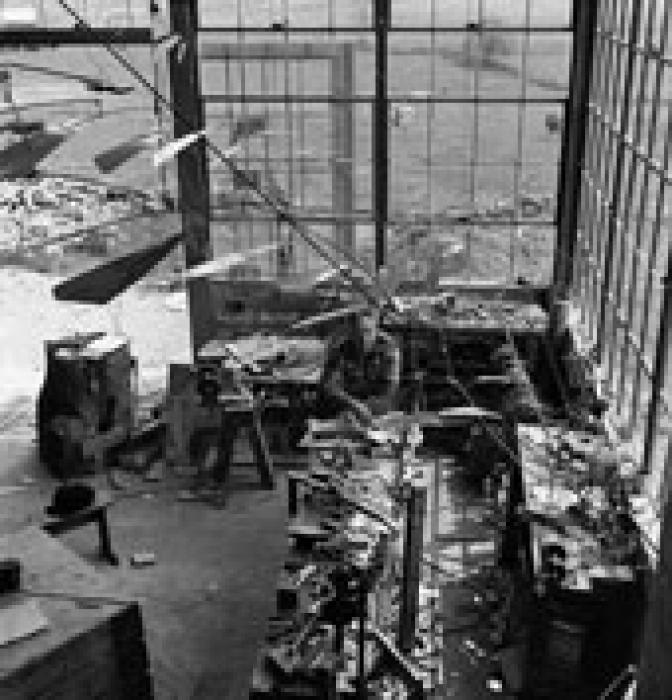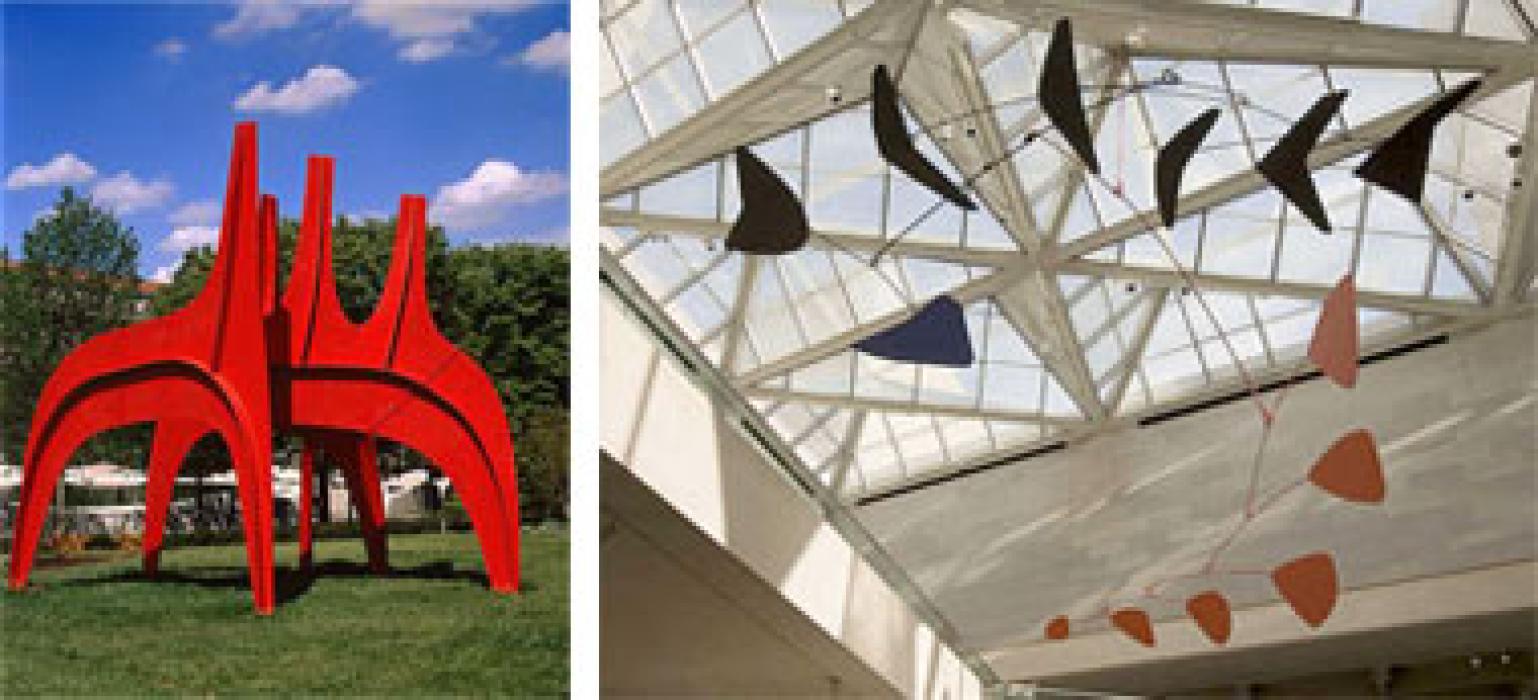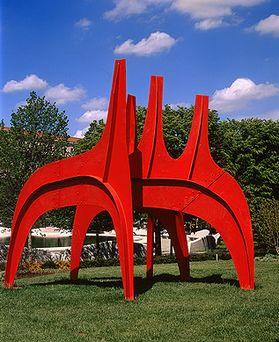Calder's Balancing Acts
Part of Counting on Art
Students will learn the vocabulary of contemporary sculpture and be able to distinguish between abstract and realistic sculpture, mobile and stabile, and biomorphic and geometric. Then they will build a Calder-style mobile online and/or offline with art supplies. Lastly, they will complete a worksheet to connect the Fibonacci sequence to a mobile by Alexander Calder.

Language
Materials
- Smart Board or computer with ability to project images from slideshow
- Wire
- String
- Paper clips
- Cardboard
- Heavy-weight paper
- Scissors
- Glue
- Poster paint
- Markers
- Computers for students to use the interactive “Mobile Maker”
- Copies of the “Spiral Patterns in Art” worksheet
Warm-Up Questions
How do you think Calder balanced this mobile? How do you imagine it moves in space?
Background
Alexander (called Sandy) Calder was born in 1898 into a very artistic family, his father and grandfather were sculptors, and his mother was a painter. As a child, he had a workshop and used tools to construct toys and gadgets with bits of wire, cloth, and string. "Mother and Father were all for my efforts to build things myself—they approved of the homemade," he explained. Calder loved to invent and play—he continued to do both throughout his life.
Calder received a degree in mechanical engineering. He worked as an engineer for a short time but then decided to study painting in New York City. He earned money by drawing illustrations for newspapers. He drew pictures of the circus for one paper and also made hundreds of animal drawings at the zoo.

Alexander Calder
Self-Portrait
crayon on paper, 5 7/8 x 9 in.
Private collection, © 2003 Estate of Alexander Calder / Artists Rights Society (ARS), New York
During his lifetime, Calder created more than 16,000 works of art, including drawings, paintings, jewelry, tapestries, stage sets, and sculptures. However, he is most famous for his moving sculptures, called mobiles. Instead of anchoring these three-dimensional works to the ground, Calder usually suspended them from the ceiling to allow them to float freely in space. To make a mobile, he attached brightly painted metal shapes to wire, using trial and error to balance each one. He usually cut natural forms that looked like leaves and petals rather than hardedge geometric shapes. Calder's engineering background came in handy as he experimented with different materials to balance and build his mobiles. His use of industrial materials—steel, aluminum, and wire—was new. When Calder's mobiles move with the breeze, they change shape and cast interesting shadows. Some even "sing" as their movable parts rub against each other.

Alexander Calder in his Roxbury, Connecticut studio, 1941
Photograph by Herbert Matter
The Alexander and Louisa Calder Foundation, New York
Guided Practice
As a class, view the slideshow below.
Slideshow: Depictions of Horses in Sculpture
Tell students that these works of art have much in common. Ask them to look carefully, to compare and contrast the images, and then list their comments on large chart paper. Prompt students to investigate each work of art with regard to the following characteristics:
- Two-dimensional/three-dimensional
- Material: metal, wood, bronze, paper, wire, canvas, paint
- Color: natural for the subject or symbolic
- Is the subject recognizable? abstract or realistic?
- Year of creation
- What conclusions can you draw? What is new and different about Calder's horses?
Now compare and contrast Calder's stabile Cheval Rouge to his mobile Untitled using the above criteria and have students clarify what is different about this work of art.

Left:
Alexander Calder
American, 1898–1976
Cheval Rouge (Red Horse), 1974
painted sheet metal
Courtesy Calder Foundation, New York
© 2002 Estate of Alexander Calder/Artists Rights Society (ARS), NY
Right: Alexander Calder
American, 1898–1976
Untitled, 1976
aluminum and steel, 910.3 x 2315.5 cm (358 3/8 x 911 5/8 in.) gross weight: 920 lb.
National Gallery of Art, Gift of the Collectors Committee
- Discuss the term mobile. How does the innovation of movement change the work of art? (movement introduces a continually changing composition)
- Has Calder created a whole new art form?
- The mobile is called Untitled. Why do you suppose Calder gave the stabile a descriptive name (Red Horse) but left the mobile without a specific title? Ask students, "What does the mobile remind you of?" (possible responses: birds in flight, wings, feathers, leaves on branches, flower petals, fish scales, a skeleton, clouds, stars, and planets)
- Tell students that Calder's sculpture is abstract but based on life forms. The term for this type of abstraction is biomorphic.
Activity
Students will build a Calder-style mobile online and/or offline with art supplies.
To make an mobile online, have students:
- Build and rotate mobiles with the “Mobile Maker” interactive.
- Optional: write and exchange mathematical problems based on their mobiles.
To make a mobile offline, with art supplies, have students:
- Read Calder's mobile-making method and philosophy:
"I used to begin with fairly complete drawings, but now I start by cutting out a lot of shapes . . . Some I keep because they're pleasing or dynamic. Some are bits I just happen to find. Then I arrange them, like papier collé [paper collage], on a table, and ‘paint’ them—that is, arrange them, with wires between the pieces if it's to be a mobile, for the overall pattern. Finally I cut some more of them with my shears, calculating for balance this time."
"I begin at the small ends, then balance in progression until I think I've found the point of support. This is crucial, as there is only one such point and it must be right if the object is to hang or pivot freely. I usually test out this point with strings to make sure before bending the wires. The size and angle of the shapes and how to use them is a matter of taste and what you have in mind."
"I feel an artist should go about his work with great respect for his materials. Symmetry and order do not make a composition. It is the apparent accident to regularity which the artist actually controls, by which he makes or mars a work."
"To most people who look at a mobile, it's no more than a series of flat objects that move. To a few, though, it may be poetry."
- Think about what they want to express with their mobiles before they begin working with materials.
- Cut and paint shapes.
- Layout wire and shapes on a table or flat surface.
- Experiment with adding/subtracting materials to make the mobile balance.
- Write a title for their mobile.
- Use string to hang it from the classroom ceiling.
- Optional: write and exchange mathematical problems based on their mobiles.
Extension
Students will complete the “Spiral Patterns in Art” worksheet to apply the Fibonacci sequence to a mobile by Alexander Calder.
Abstract: style of art that does not represent its subject matter in a realistic way. It emphasizes the elements of art—line, color, shape, texture, and form—to express its subject.
Realistic: art that seeks to produce a true-to-life representation of its subject matters; its shapes and forms are recognizable as people, places, or things.
National Core Arts Standards
VA:Cr2.1.8 Demonstrate willingness to experiment, innovate, and take risks to pursue ideas, forms, and meanings that emerge in the process of art-making or designing.
VA:Cr2.3.7 Apply visual organizational strategies to design and produce a work of art, design, or media that clearly communicates information or ideas.
VA:Re7.1.7 Explain how the method of display, the location, and the experience of an artwork influence how it is perceived and valued.
VA:Re8.1.7 Interpret art by analyzing art-making approaches, the characteristics of form and structure, relevant contextual information, subject matter, and use of media to identify ideas and mood conveyed.
You may also like

Educational Resource: Horace Pippin's Story, Grade Level: 1–2
Students will learn about the life and painting style of African-American artist Horace Pippin. They will discover how to "read" the clues in his painting School Studies and write a story about the work. By solving counting and time problems, students will also create their own "secret number" painting.





